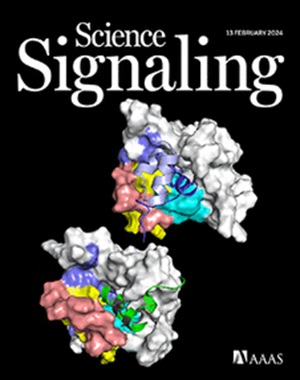定义支持KRAS和erk依赖性胰腺癌生长的myc调控转录组和kinome
IF 6.6
1区 生物学
Q1 BIOCHEMISTRY & MOLECULAR BIOLOGY
引用次数: 0
摘要
在胰腺导管腺癌(PDAC)的kras突变信号网络中发现的数千个基因和底物中,超过200个是转录因子,这意味着广泛而复杂的转录调控。然而,我们观察到,转录因子MYC的遗传抑制足以表型KRAS抑制对PDAC细胞信号传导、生长和代谢过程的影响。我们确定了kras突变PDAC细胞系中MYC功能急性抑制引起的基因转录变化,并对受影响的基因集进行了依赖图和途径分析。1685个基因的表达随着MYC的抑制而增加,这些基因可能包含了PDAC生长所必需的MYC调节基因的大部分。相比之下,表达被抑制的1325个基因可能包含对致癌应激的代偿反应,部分由GTPase RHO介导。MYC依赖性转录活性在很大程度上依赖于ERK,在PDAC细胞中,几乎三分之一的ERK调节基因也受MYC调节。此外,化学蛋白质组学分析显示myc调节的蛋白激酶可以靶向治疗。总之,这些数据提供了myc依赖性信号的分子图谱,包括治疗PDAC的潜在可利用机制。本文章由计算机程序翻译,如有差异,请以英文原文为准。

Defining the MYC-regulated transcriptome and kinome that support KRAS- and ERK-dependent growth of pancreatic cancer
Of the thousands of genes and substrates identified in KRAS-mutant signaling networks in pancreatic ductal adenocarcinoma (PDAC), more than 200 are transcription factors, implying extensive and complex transcriptional regulation. However, we observed that genetic suppression of the transcription factor MYC alone was sufficient to phenocopy the effect of KRAS suppression in signaling, growth, and metabolic processes in PDAC cells. We determined the gene transcription changes caused by acute suppression of MYC function in KRAS-mutant PDAC cell lines and performed dependency map and pathway analyses on the affected gene sets. The expression of 1685 genes was increased upon suppression of MYC, and this gene set may comprise the bulk of the MYC-regulated genes essential for PDAC growth. In contrast, the 1325 genes whose expression was inhibited may comprise a compensatory response to oncogenic stress, mediated in part by the GTPase RHO. MYC-dependent transcriptional activity was largely ERK dependent, and almost one-third of ERK-regulated genes were also regulated by MYC in PDAC cells. Furthermore, chemical proteomic profiling revealed MYC-regulated protein kinases that can be targeted therapeutically. Together, these data provide a molecular portrait of MYC-dependent signaling that encompasses potentially exploitable mechanisms for treating PDAC.
求助全文
通过发布文献求助,成功后即可免费获取论文全文。
去求助
来源期刊

Science Signaling
BIOCHEMISTRY & MOLECULAR BIOLOGY-CELL BIOLOGY
CiteScore
9.50
自引率
0.00%
发文量
148
审稿时长
3-8 weeks
期刊介绍:
"Science Signaling" is a reputable, peer-reviewed journal dedicated to the exploration of cell communication mechanisms, offering a comprehensive view of the intricate processes that govern cellular regulation. This journal, published weekly online by the American Association for the Advancement of Science (AAAS), is a go-to resource for the latest research in cell signaling and its various facets.
The journal's scope encompasses a broad range of topics, including the study of signaling networks, synthetic biology, systems biology, and the application of these findings in drug discovery. It also delves into the computational and modeling aspects of regulatory pathways, providing insights into how cells communicate and respond to their environment.
In addition to publishing full-length articles that report on groundbreaking research, "Science Signaling" also features reviews that synthesize current knowledge in the field, focus articles that highlight specific areas of interest, and editor-written highlights that draw attention to particularly significant studies. This mix of content ensures that the journal serves as a valuable resource for both researchers and professionals looking to stay abreast of the latest advancements in cell communication science.
 求助内容:
求助内容: 应助结果提醒方式:
应助结果提醒方式:


